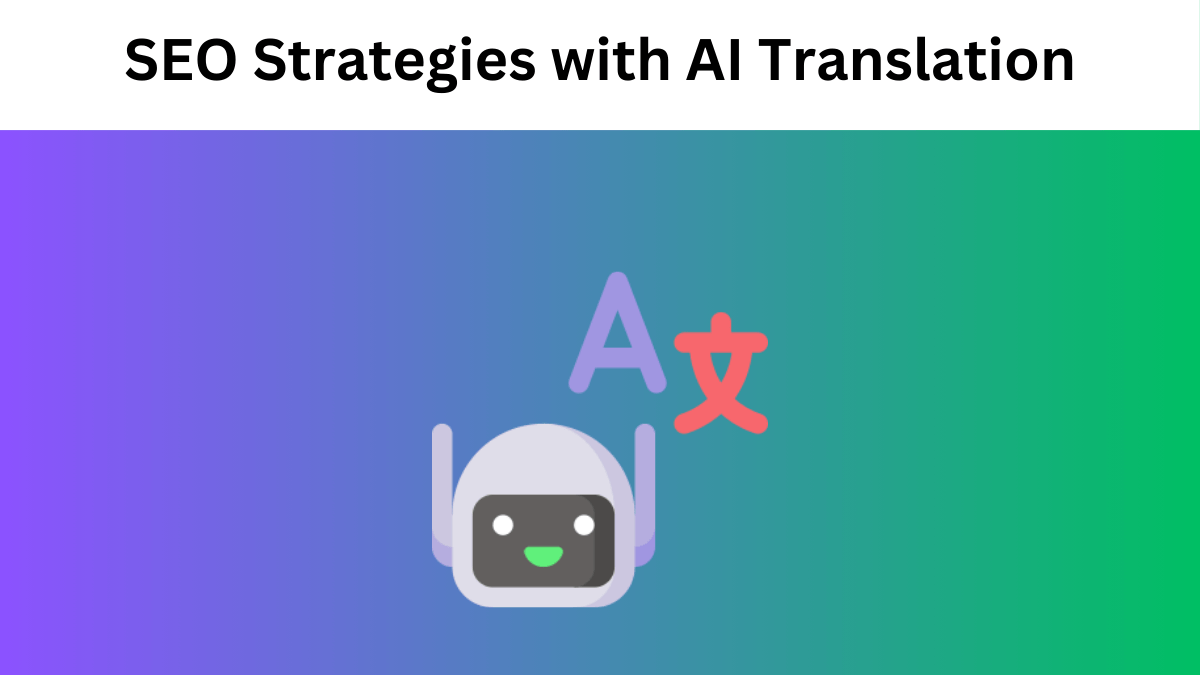Advanced SEO Strategies with AI Translation for Multilingual Websites
Running a multilingual website is not just about translating content and hoping it rises in Google rankings. Advanced SEO Strategies with AI translation for your multilingual websites allow businesses to reach a global audience more effectively. With AI translation, content can be contextually customized, avoid indexation errors, and remain relevant to users in different countries.
Contents
In this article, we will discuss how AI translation can overcome the limitations of regular translation and advanced SEO strategies powered by AI, as well as how to implement them using the best tools.
Why Basic Translation Isn’t Enough for Multilingual SEO?

Translating a website into multiple languages is a crucial first step in reaching a global audience, but it’s not enough to ensure optimal SEO. Basic translation often fails to capture language nuances, cultural context, and the technical structure needed for high search engine rankings. Without further optimization, multilingual websites risk indexing errors, missed ranking opportunities, or confusion among local users.
- Context & Relevance Errors – Standard translation tools often translate words literally without considering local meanings or commonly used terms in specific countries.
- Failure to Optimize Local Keywords – Automated translations don’t always capture the most searched keywords in the target language, leading to lower search rankings.
- Incorrect URL Structure and Hreflang Implementation – Basic translation doesn’t properly configure URL structure and hreflang tags, making it harder for Google to identify the correct language version. This can cause indexing issues or duplicate content.
- Issues with Metadata & Structured Data – Basic translations often overlook critical elements like title tags, meta descriptions, and schema markup, directly affecting search visibility.
To ensure effective SEO, AI-powered translation provides a superior solution by considering linguistic context, keyword optimization, and technical structures that enhance indexing across global markets.
Advanced SEO Strategies Enabled by AI Translation

With the right AI implementation, websites can enhance their multilingual SEO strategies. Here are some advanced SEO strategies supported by AI translation:
1. AI-Driven Keyword Localization
One of the biggest mistakes in multilingual SEO is directly translating keywords without considering how users in different countries search. AI translation powered by Natural Language Processing (NLP) can analyze local search trends and adjust keywords based on user behavior in specific regions.
For example, English-speaking users might search for “cheap flights,” while Spanish users are likelier to use “vuelos baratos.” If translation is done literally without considering search volume, ranking opportunities may be lost. With AI, keyword localization is automated based on real-time data, improving SEO effectiveness across languages.
2. Dynamic Content Optimization for Local Relevance
AI translation enables content to be translated and adapted to local preferences. AI algorithms can recognize idioms, common phrases, and natural language styles suited to target audiences.
For instance, an e-commerce site targeting Japanese users may need a more formal tone than one for the American market, which tends to be more casual. AI translation detects these patterns and delivers more relevant translations, increasing engagement and user time spent on pages.
3. Automated Hreflang Tag Implementation
Google relies on hreflang tags to understand a page’s language and target location. Incorrect implementation can lead to the wrong pages appearing in search results or duplicate content issues in Google’s index.
With AI translation integrated with SEO tools, hreflang tags can be applied automatically and accurately for each language and region. For example, AI can determine that a page should be tagged with hreflang=”fr-FR” for French users or hreflang=”es-MX” for Mexican users, preventing overlap that could confuse search engines.
4. AI-Assisted Meta Tag & Structured Data Optimization
Manual translation often overlooks critical SEO elements such as title tags, meta descriptions, and schema markup, significantly impacting search rankings.
AI translation can automatically adjust title tags to remain compelling across different languages. For example, if the English meta description reads, “Find the best budget hotels in Paris with exclusive discounts”, AI can adapt it into German as “Finden Sie die besten Budget-Hotels in Paris mit exklusiven Rabatten” preserving the original marketing appeal.
5. AI-Powered Content Gap Analysis
Even if a website offers content in multiple languages, topic coverage often varies across different versions. AI can conduct in-depth content analysis to identify gaps in multilingual SEO strategies.
For example, a tech blog with extensive AI-related articles in English may have fewer such articles in Spanish. With AI-powered content gap analysis, website owners can determine which areas need expansion or updates to ensure balanced and optimized SEO coverage across all languages.
Implementing AI Translation and Tools

AI translation must be implemented strategically to achieve the best results—from selecting the right tools to technical optimizations like hreflang and URL structure. Here are the key steps in implementing AI translation and tools to enhance multilingual SEO performance.
1. Choosing the Right AI Translation Tool
Selecting an appropriate AI translation tool is crucial to ensuring high-quality translations that support multilingual SEO. The choice should align with specific needs, prioritizing automation, accuracy, or editing flexibility.
Ensure the tool can translate multiple pages simultaneously or update translations automatically when content changes while supporting multilingual SEO implementation.
2. Integration with CMS and Website
Using AI translation efficiently within a website is essential to maintaining SEO structure. Some translation tools support CMS platforms like WordPress, Joomla, and Shopify. Integrating with Google Translate API or DeepL API via the backend enables real-time content updates for custom-built websites.
With proper implementation, AI translation speeds up the translation process and preserves a high-quality user experience across different language versions.
3. Optimizing Hreflang and URL Structure
Without technical optimizations like hreflang tags and proper URL structures, automatic translation alone isn’t enough. Hreflang tags help search engines identify the correct language version for users based on their location, preventing indexing errors or duplicate content issues.
For example, the tag <link rel=”alternate” hreflang=”fr” href=”https://example.com/fr/”> indicates that the page is the French version of the main site. Additionally, the choice of URL structure—whether subfolders (example.com/fr/), subdomains (fr.example.com), or ccTLDs (example.fr)—should be based on SEO strategy and target market considerations.
4. AI + Human Editing for Accuracy
Despite advancements in AI translation, post-human editing is still necessary to ensure accuracy and contextual relevance. AI translates quickly but may not fully grasp language nuances, technical terms, or cultural expressions specific to each market.
After AI translation, human editors must refine the content to keep it natural, relevant, and SEO-friendly. For example, in the travel industry, the English phrase “all-inclusive resort” should be translated into Spanish as “resort todo incluido” rather than “resort todo abarcador,” which sounds unnatural and overly literal. By combining AI with human editing, local translators can fine-tune translations to ensure they resonate with the target audience while maintaining SEO effectiveness.
5. Enhancing Site Performance for Multilingual SEO
Implementing AI translation should not compromise site speed and performance, as these factors directly impact SEO rankings and user experience. Poorly optimized multilingual sites may suffer from slow loading times due to excessive JavaScript, large translation databases, or inefficient caching strategies. To optimize performance:
- Use Lightweight AI Translation Solutions – Avoid excessive reliance on client-side translation scripts, which can slow down page rendering. Instead, opt for server-side translation processing or pre-rendered translated pages.
- Implement Caching Strategies – Use Content Delivery Networks (CDNs) to cache translated pages efficiently, reducing server load and speeding up content delivery for international users.
- Optimize Images and Media Files – Ensure translated pages do not contain redundant high-resolution images that slow down page speed. Use lazy loading techniques and optimized media formats like WebP.
Conclusion
Optimizing multilingual SEO with AI translation helps ensure that translations are relevant, easily indexed by search engines, and appealing to a global audience. With strategies such as keyword localization, meta-tag optimization, and accurate hreflang implementation, AI translation can improve a site’s visibility in various markets without compromising the quality of user experience.
Integrating AI with CMS, selecting the right tools, and combining AI and human editing will provide more optimal results. With this approach, businesses can utilize AI translation as a tool that speeds up the translation process and strengthens their overall SEO strategy.
